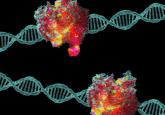Paper strip test using CRISPR and SHINE technology has been developed for rapid influenza diagnosis

In their recent publication in The Journal of Molecular Diagnostics, a team spanning The Broad Institute of MIT and Harvard (both MA, USA) and Princeton University (NJ, USA) has developed a paper strip test able to distinguish between the two main types of seasonal influenza, A and B. The low-cost test is also able to recognize strains that are resistant to antiviral treatment and could in the future detect swine and avian flu strains, including H5N1, which is currently infecting cattle.
The paper strip test will hopefully allow more patients to find out which type of influenza they have to guide their treatment options, which in turn could help to improve outbreak response and clinical care. The test was designed to be rapid and affordable, improving the accessibility of these types of tests, which further improves patient care and disease monitoring.
“Using a paper strip readout instead of expensive fluorescence machinery is a big advancement, not only in terms of clinical care but also for epidemiological surveillance purposes,” explained Ben Zhang, a Harvard Medical School student and co-first author on the study.
The test uses the technology SHINE — Streamlined Highlighting of Infections to Navigate Epidemics — and uses CRISPR enzymes to identify specific viral RNA sequences. SHINE has a runtime of 90 minutes, can be used at room temperature and only requires an inexpensive heat block to heat the reaction. The SHINE technology has previously been used to identify SARS-CoV-2 and later to distinguish between the Delta and Omicron variants. In this case, the researchers were able to distinguish between influenza A and B, as well as the subtypes H1N1 and H3N2.
You may also be interested in:
- Multiplexed paper-based biosensor for point-of-care testing
- COVID vs flu vaccinations: are they similar?
- Novel gene editor proves to be a pint-sized powerhouse
“Ultimately, we hope these tests will be as simple as rapid antigen tests, and they’ll still have the specificity and performance of a nucleic acid test that would normally be done in a laboratory setting,” commented Cameron Myhrvold, Assistant Professor at Princeton University and co-senior author on the study along with Pardis Sabeti, Institute Member at the Broad Institute and a Professor at Harvard University and the Harvard T.H. Chan School of Public Health, as well as a Howard Hughes Medical Institute (MD, USA) Investigator.
The team plans to adapt SHINE to test for avian and swine influenza strains:
“With SARS-CoV-2 and now flu, we’ve shown that we can easily adapt SHINE to detect new or evolving viruses. We’re excited to apply it to H5N1,” explained Jon Arizti-Sanz, Postdoctoral Researcher in Sabeti’s lab and co-first author of the study.






